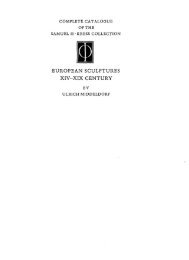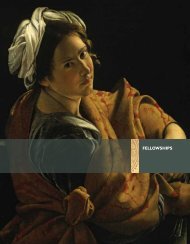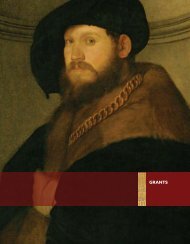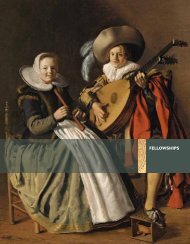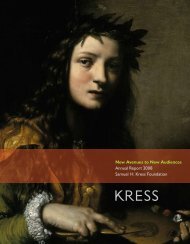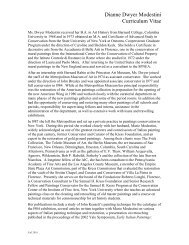The Campus Art Museum - Samuel H. Kress Foundation
The Campus Art Museum - Samuel H. Kress Foundation
The Campus Art Museum - Samuel H. Kress Foundation
You also want an ePaper? Increase the reach of your titles
YUMPU automatically turns print PDFs into web optimized ePapers that Google loves.
talk about the objects, and they tell all kinds of stories about how the children<br />
respond. <strong>The</strong>y have students thinking about how could they make connections<br />
between these objects and their curriculum, how can they make a link between<br />
this still life and science or math or all of the things they have to teach.<br />
Courses in languages, museum studies, art education, and the arts are not<br />
the only ones to use the museum as a way to practice disciplinary skills; others<br />
do so as well. A pharmacology professor made use of a collection of photographs<br />
of HIV patients to get students to practice medical observation skills. 8 An algebra<br />
class spent time at a Frank Lloyd Wright house, affiliated with the museum, doing<br />
algebra assignments to work out aspects of the design and construction of the<br />
house. And music classes often link with the museum to practice their playing and<br />
provide concerts during an art opening or other special events.<br />
Interdisciplinary Analysis<br />
Interdisciplinary use of the museum—crossing disciplinary boundaries and<br />
connecting diverse schools of thought—contributes to new understandings. Of<br />
those interviewed, music and literature professors most often used the campus art<br />
museum in cross-disciplinary ways, but others did so as well. This section describes<br />
how interdisciplinary analysis may take place.<br />
<strong>Art</strong> works well to complement and extend the concepts music professors<br />
tend to teach. One professor, for example, annually rotates his geographical focus<br />
in his course on historical musical performances. Each year, he takes students<br />
to the print study room where a curator displays works corresponding to the era<br />
and location of the performances. Together the group analyzes what is happening<br />
visually and musically and how each informs the other. A student reflected on how<br />
a professor with a similar approach got them to think about music history through<br />
assignments that required visits to the campus art museum:<br />
I took both a Medieval-Renaissance class and a Baroque Music History class…<br />
and two of our papers, graded assignments, were to go over to the museum<br />
and look at specific works chosen by the professor.… He’d pick a work, such as<br />
a Medieval work, and he’d say, “Go to the [campus art museum], look at this<br />
work, and think about all you’ve learned in music history about the overarching<br />
style of the Medieval period…. How does it relate to the piece of art that you’re<br />
looking at?” We had to write a two-page paper about it. Initially, everybody’s<br />
reaction was, “I don’t want to do this, I don’t want to go to the museum.” And it<br />
turned out to be everybody’s favorite assignment. People take more classes with<br />
him. <strong>The</strong>y take the Medieval-Renaissance class and then they take the Baroque<br />
class and they see the assignment again and they go, “Yeah, the museum piece.”<br />
Everyone gets really excited about that one. It’s not that difficult, particularly<br />
because there are so many parallels between music and art, and that’s what<br />
you’re supposed to learn. It’s an enjoyable exercise because you already have<br />
8. Alexa Miller, an arts learning specialist, draws attention to combining visual arts and medical training through her work<br />
to improve Harvard Medical students’ observation and diagnostic skills in a time of increased reliance on technology.<br />
See Kowalczyk 2008.<br />
Meeting Course Objectives through the <strong>Art</strong> <strong>Museum</strong><br />
13



